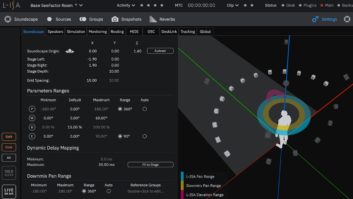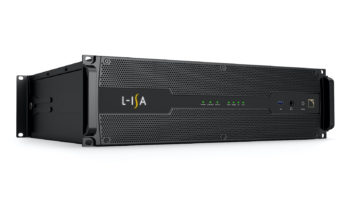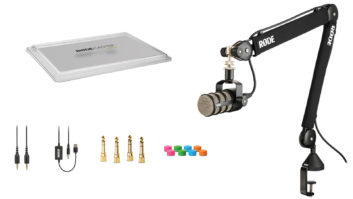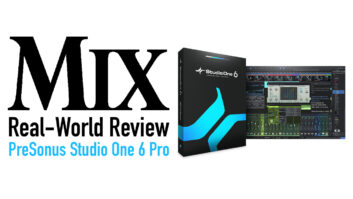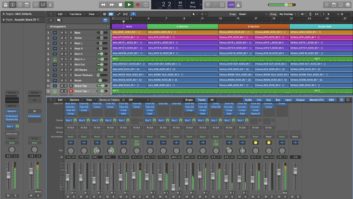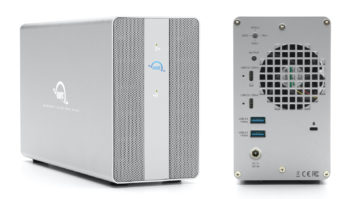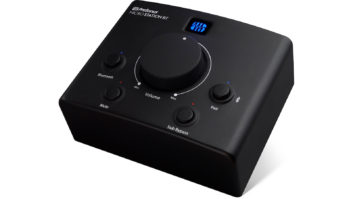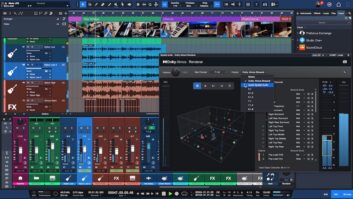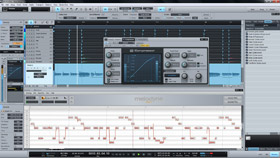
At the end of 2009, I first became familiar with Studio One and was immediately impressed with the overall look, ease of use and extensive features. The next upgrade, Version 1.5, added QuickTime movie imports, uploads to SoundCloud integrated into the mastering suite, “time stretching” and numerous other tweaks and improvements in response to user feedback. My expectations were high for V. 2, reviewed here, especially with radical innovations like the first DAW implementation of Celemony’s Melodyne ARA technology, which seamlessly integrates the popular pitch-correction software into Studio One.
MELODYNE INTEGRATION
Studio One’s new Melodyne integration is powerful. Instead of transferring audio into Melodyne, tweaking it and then rendering it, any region can simply be invited to “Edit With Melodyne.” At that point, the Melodyne interface appears in a window much like the Studio One Waveform Editor window, the audio is analyzed and you can process Melodyne pitch and time correction in place. The Melodyne window can be closed, and then you can return to the Melodyne window later and pick up where you left off. So far, sounds no different than what you are used to, right?
The novelty comes from the fact that now, that region, whose pitch has been corrected, can be dragged, nudged or trimmed in the regular audio timeline, and upon returning to the Melodyne editor there is no need to re-transfer. The Melodyne edits are locked to the region, or even the audio underlying the region, and no longer to the transferred audio recorded into the plug-in. The region in the Edit window will display its Melodyne information in an appearance like looking at a MIDI region on top of an audio region. Any Melodyne operation can be undone or done differently at will. This is absolutely a great concept, and at times it was incredibly useful; however, I’m eager to see this idea evolve even further. For example, the tools in the Melodyne editor can’t be accessed with any keyboard shortcuts. Zooming using shortcuts is also unavailable in the Melodyne editor. Eventually, I would love to see the PreSonus tools and shortcuts apply to the integrated Melodyne editor, creating a truly connected experience.

As cool as the new integration of Melodyne is, I did have some issues. I first tried the Melodyne editor on an old session that I had originally recorded using Studio One V. 1.5. At that point, the software didn’t offer multitake comping. Back then, I recorded vocal takes on different tracks and then manually solo’d, chopped and comp’d to one track. I selected all the regions of the first verse, which had been comp’d starting with a piece of Take 3, then a word or two from Take 2, back to Take 3 and then it finished with Take 1. With all of these regions selected, I chose the “Edit With Melodyne” command, but instead of loading the whole verse into the Melodyne editor, only the last region in the selection was loaded.
Melodyne displayed the entire underlying audio passage of Take 1 and highlighted the section that was actually being used in the track. Naturally, only that highlighted section was audible during playback. Technically, this was correct, and if I manipulated the underlying audio that was not being used in that particular region, it still updated any other region using the same audio. The result, though, was that I had to pitch-correct the verse region by region if I wanted to take advantage of the new style of editing, making it a cumbersome process to try to hear and adjust the pitch effects while playing back the rest of the tracks in the session. In the end, I found it much more advantageous to simply transfer into a regular plug-in instance the old way, and there the entire passage could be listened to in the context of the song.

Studio One includes plug-ins like the IR Maker and the Open Air convolution reverb.
COMPING PLUS
Studio One V. 2 offers multitake comping, which looks and performs nearly identically to Pro Tools playlist comping, just a little bit better and a little bit worse. The “layers,” as Studio One calls “playlists,” are multi-colored, and a little arrow button near the track name shoots the selected take up to the main layer. Unfortunately, if you select only one word within a particular region and hit the arrow button, that doesn’t matter: The whole region will move up to the main playlist. It didn’t take long to find a keyboard shortcut to “copy range to track,” only moving the selected audio to the master playlist. Where Studio One gets even better than Pro Tools comping is that rather than having to solo a layer and press spacebar to hear that take, simply Option + clicking a region auditions that layer in Studio One. Best of all, when using the multitake comping function, the result is a lot of pieces of a lot of takes all sitting on one track. If all of those regions are selected and commanded to “Edit With Melodyne,” the function behaves like you would otherwise expect it to. All regions will play consecutively in the editor, and pitch correction is practical and convenient.
TIGHTENING TIMING
Another highly anticipated pair of features is the ability to add silence between sound events and to quantize audio to a grid. The Strip Silence feature offers one of the crudest versions of that function that I’ve come across in any DAW. Anyone that has used Pro Tools or Nuendo to extract or eliminate noise between snare hits, for example, is used to graphic feedback showing what will be kept, what will be trimmed and how tight the chopping will be while adjusting settings. Studio One gives no indication of what is going to happen, aside from numbered values for the threshold, minimum duration, pre- and post-roll (region start and end pad), and auto-generated fade lengths. It’s up to you to guess, attempt, undo, tweak and try again. I found this to be difficult at best.
The Quantize function, akin to Beat Detective, was implemented with far more grace. Studio One V. 2 introduces “audio bending,” which behaves very much like Logic’s Flex Time. Flex Time was the jaw-dropping feature that allowed you to set up anchor points within a waveform and stretch individual sections, not the entire waveform. This feature is great for holding notes in vocals for extra time, sustaining guitar chords a bit longer and—as Logic and now Studio One use it—quantizing drum hits. Multitracked drums in Studio One can be grouped, transients can be detected, and the whole set can be phase-coherently quantized to a grid, tastefully squeezing decays to accommodate the shifting of attacks into place.
OTHER ODDS AND ENDS
Studio One V. 2 includes many other small, yet strong improvements. Groups of tracks can be packaged into a collapsible folder in the Edit window, making it easier to manage the workspace. A track list on the left-hand side of the screen lets you show and hide tracks, as Pro Tools users would be accustomed. A tone generator was added and done well. It does the usual sine, saw, rectangle and noise, but adds tone sweeps and bends. Ampire XT, the guitar amp emulator, got a major overhaul, adding convolved cabinet designs and mic placement. The most exciting new plug-in pair is the IR Maker and the OpenAIR convolution reverb. Collecting impulses is a breeze with IR Maker, and organizing them is made easy with the plug-in. Using your own models in OpenAIR is as easy as dragging and dropping. The new Dual Pan plug-in provides for each channel of a stereo track, like you would find in Pro Tools—a welcome addition.
The mastering suite also got some improvements. Now a project can be completed, burned to a reference disc, sent for duplication as a DDP file and still be released on Sound Cloud as MP3s. I am glad to see the new DDP option. I’d love to see AAC exports in the near future, and maybe real-time codec auditioning like we’ve seen from the Sonnox Fraunhofer suite.
Out of the gate, Studio One aimed to provide “All Muscle, No Bloat,” and served that mission well. In V. 2, the menus are lengthier, big new features are flashy and it’s packed with strong, subtle improvements. If the company commits to staying trim, fixing the quirks of already-included features and simply adding little niceties along the way, I think there is a bright future ahead.
Brandon Hickey is a freelance engineer and audio educator.

Click on the Product Summary box above to view the PreSonus Studio One Pro Version 2 product page.
